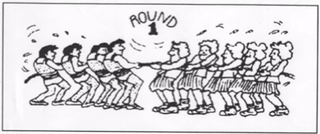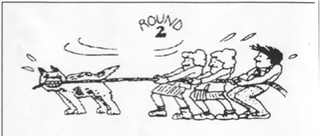There seems to be a lot of research telling us how important feedback is to student performance, however, there’s little discussion about how we give this feedback and what the feedback actually looks like in mathematics. To start with, here are a few important points research says about feedback:
- The timing of feedback is really important
- The recipient of the feedback needs to do more work than the person giving the feedback
- Students need opportunities to do something with the feedback
- Feedback is not the same thing as giving advice
I will talk about each of these toward the end of this post. First, I want to explain a piece about feedback that isn’t mentioned enough… Providing students with feedback positions us and our students as learners. Think about it for a second, when we “mark” things our attention starts with what students get right, but our attention moves quickly to trying to spot errors. Basically, when marking, we are looking for deficits. On the other hand, when we are giving feedback, we instead look for our students’ actual thinking. We notice things as almost right, we notice misconceptions or overgeneralization…then think about how to help our students move forward. When giving feedback, we are looking for our students strengths and readiness. Asset thinking is FAR more productive, FAR more healthy, FAR more meaningful than grades!
Feedback Doesn’t Just Happen at the End!
Let’s take an example of a lesson involving creating, identifying, and extending linear growing patterns. This is the 4th day in a series of lessons from a wonderful resource called From Patterns to Algebra. Today, the students here were asked to create their own design that follows the pattern given to them on their card.






Once students made their designs, they were instructed to place their card upside down on their desk, and to circulate around the room quietly looking at others’ patterns. Once they believed they knew the “pattern rule” they were allowed to check to see if they were correct by flipping over the card.
After several minutes of quiet thinking, and rotating around the room, the teacher stopped everyone and led the class in a lesson close that involved rich discussions about specific samples around the room. Here is a brief explanation of this close:
Teacher: Everyone think of a pattern that was really easy to tell what the pattern rule was. Everyone point to one. (Class walks over to the last picture above – picture 6). What makes this pattern easy for others to recognize the pattern rule? (Students respond and engage in dialogue about the shapes, colours, orientation, groupings…).
Teacher: Can anyone tell the class what the 10th position would look like? Turn to your partner and describe what you would see. (Students share with neighbor, then with the class)
Teacher: Think of one of the patterns around the room that might have been more difficult for you to figure out. Point to one you want to talk about with the class. (Students point to many different ones around the room. The class visits several and engages in discussions about each. Students notice some patterns are harder to count… some patterns follow the right number of tiles – but don’t follow a geometric pattern, some patterns don’t reflect the pattern listed on the card. Each of these noticings are given time to discuss, in an environment that is about learning… not producing. Everyone understands that mistakes are part of the learning process here and are eager to take their new knowledge and apply it.
The teacher then asks students to go back to their desks and gives each student a new card. The instructions are similar, except, now she asks students to make it in a way that will help others recognize the patterns easily.
The process of creating, walking around the room silently, then discussing happens a second time.
To end the class, the teacher hands out an exit card asking students to articulate why some patterns are easier than others to recognize. Examples were expected from students.
At the beginning of this post I shared 4 points from research about feedback. I want to briefly talk about each:
The timing of feedback is really important
Feedback is best when it happens during the learning. While I can see when it would be appropriate for us to collect items and write feedback for students, having the feedback happen in-the-moment is ideal! Dan Meyer reminds us that instant feedback isn’t ideal. Students need enough time to think about what they did right/wrong… what needs to be corrected. On the other hand, having students submit items, then us giving them back a week later isn’t ideal either! Having this time to think and receive feedback DURING the learning experience is ideal. In the example above, feedback happened several times:
- As students walked around looking at patterns. After they thought they knew the pattern, they peeked at the card.
- As students discuss several samples they are given time to give each other feedback about which patterns make sense… which ones visually represented the numeric value… which patterns could help us predict future visuals/values
- Afterward once the teacher collected the exit cards.
The recipient of the feedback needs to do more work than the person giving the feedback
Often we as teachers spend too much time writing detailed notes offering pieces of wisdom. While this is often helpful, it isn’t a feasible thing to do on a daily basis. In fact, us doing all of the thinking doesn’t equate to students improving! In the example above, students were expected to notice patterns that made sense to them, they engaged in conversations about the patterns. Each student had to recognize how to make their pattern better because of the conversations. The work of the feedback belonged, for the most part, within each student.
Students need opportunities to do something with the feedback
Once students receive feedback, they need to use that feedback to continue to improve. In the above example, the students had an opportunity to create new patterns after the discussions. After viewing the 2nd creations and seeing the exit cards, verbal or written feedback could be given to those that would benefit from it.
Feedback is not the same thing as giving advice
This last piece is an interesting one. Feedback, by definition, is about seeing how well you have come to achieving your goal. It is about what you did, not about what you need to do next. “I noticed that you have switched the multiplicative and additive pieces in each of your patterns” is feedback. “I am not sure what the next position would look like because I don’t see a pattern here” is feedback. “The additive parts need to remain constant in each position” is not feedback… it is advice (or feedforward).
In the example above, the discussions allowed for ample time for feedback to happen. If students were still struggling, it is appropriate to give direct advice. But I’m not sure students would have understood any advice, or retained WHY they needed to take advice if we offered it too soon.
So I leave you with some final questions for you:
- When do your students receive feedback? How often?
- Who gives your students their feedback?
- Is it written? Or verbal?
- Which of these do you see as the most practical? Meaningful for your students? Productive?
- How do you make time for feedback?
- Who is doing the majority of the work… the person giving or the person receiving the feedback?
- Do your students engage in tasks that allow for multiple opportunities for feedback to happen naturally?
PS. Did you notice which of the students’ examples above had made an error. What feedback would you give? How would they receive this feedback?


















